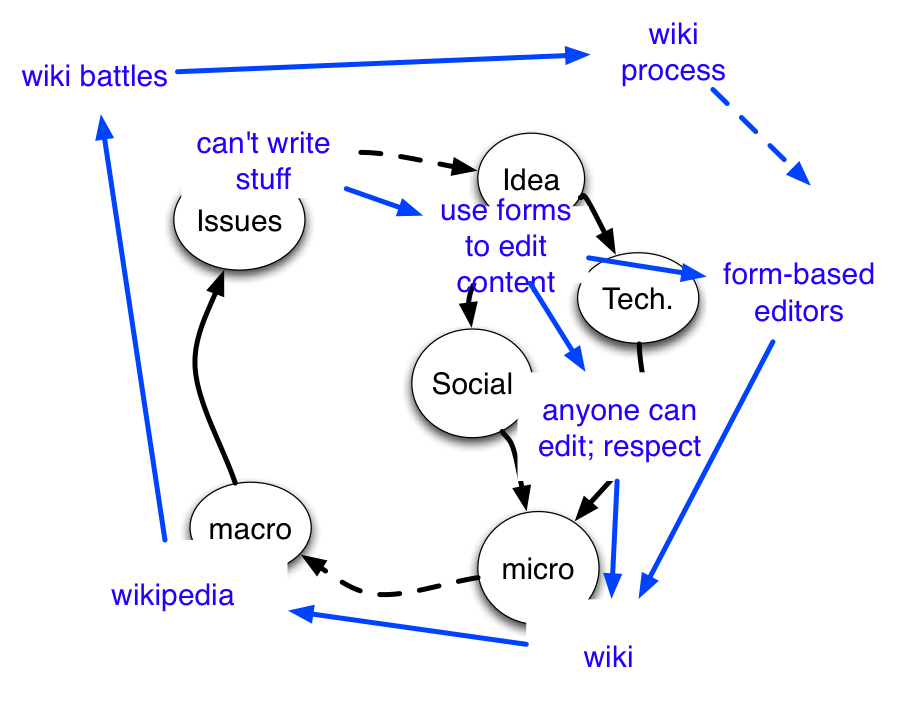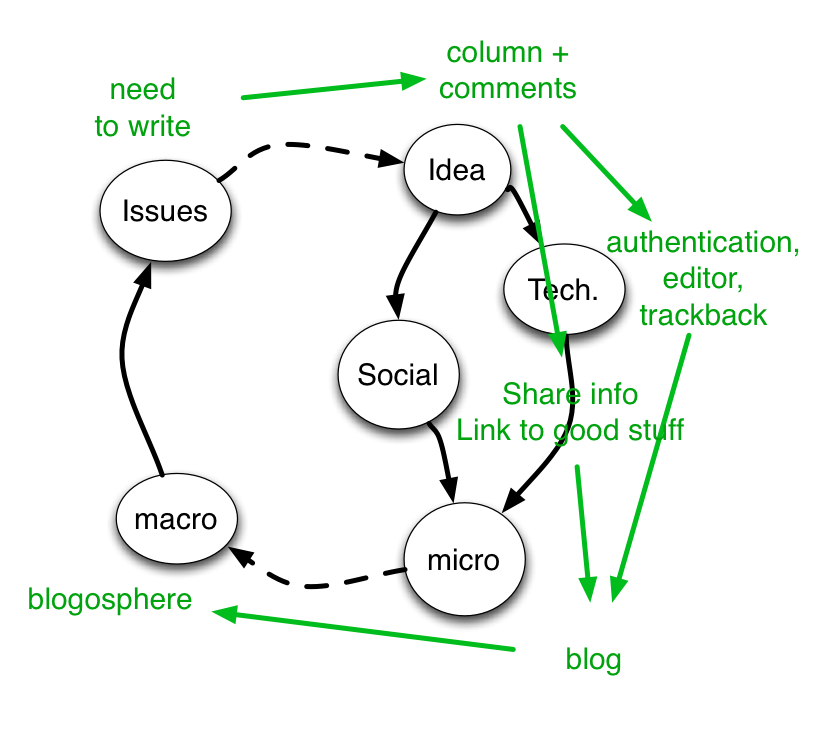Presentation Goals
- Demystify Linked Data
- Demonstrate the unobtrusive nature of Linked Data
- Explore how Linked Data can Work for You!
Situation Analysis
- User Generated Content is Growing Exponentially
- Enterprise & Individual Connectivity is Growing
- The Line Between The Individual & The Enterprise is Blurring
- Agility is Increasingly an Expression of Vitality
- But There are still only 24hrs in a Day!
A Few Definitions
- What is Data?
- How we express observation
- What is Information?
- How we use Context to perceive observation
- What is Knowledge?
- How we Comprehend what we perceive
Important (IMHO) Note!
- Data, Information, and Knowledge are subjective terms
- Context [of the beholder] ultimately determines what's actually what
- Data is the lowest common denominator
- Everything we do in IT ultimately comes down to Access, Manipulation, and Dissemination of Data across a spectrum of Context vectors.
What is Data Access by Reference?
- How you access "Data" using Data Source Names (Identifiers)
- Identifiers may be Natural (human readable) or Synthetic (machine readable)
Data Source Name Examples
- ODBC
- JDBC URL
- LSID URN for "Elephant-eared kangaroo rat" from Universal Biological Indexer & Organizer
- Information Resource Uniform Resource Identifiers (URIs)
- Data Web Entity (that isn't an Information Resource) Identifier
What is Linked Data?
- A term coined by Tim Berners-Lee that describes HTTP-based Data Access by Reference for the Web
- A richer Linking mechanism for the Web that takes us from Hypertext Links (Document to Document) to Hyperdata Links (across things that documents are about)
Why is Linked Data Important?
- It exposes the compound nature of Web Resources
- It provides an Open Data Access & Connectivity mechanism for the Web
- It delivers a powerful mechanism for meshing disparate and heterogeneous data sources
- It offers an unobtrusive mechanism for unveiling the prowess of the broader Semantic Web vision.
Linked Data Tenets
- Give Names to things you describe so that they become uniquely Identifiable Resources (Data Sources)
- Incorporate HTTP into your naming scheme so that you extend data access scope to your internal networks and/or the World Wide Web
Network: Routers link Computers

Internet Application Abstraction: Cloud hides Routers

Internet: Computers linked to Documents

Web Application Abstraction: Web Pages hide Computers

Web: Documents links Documents
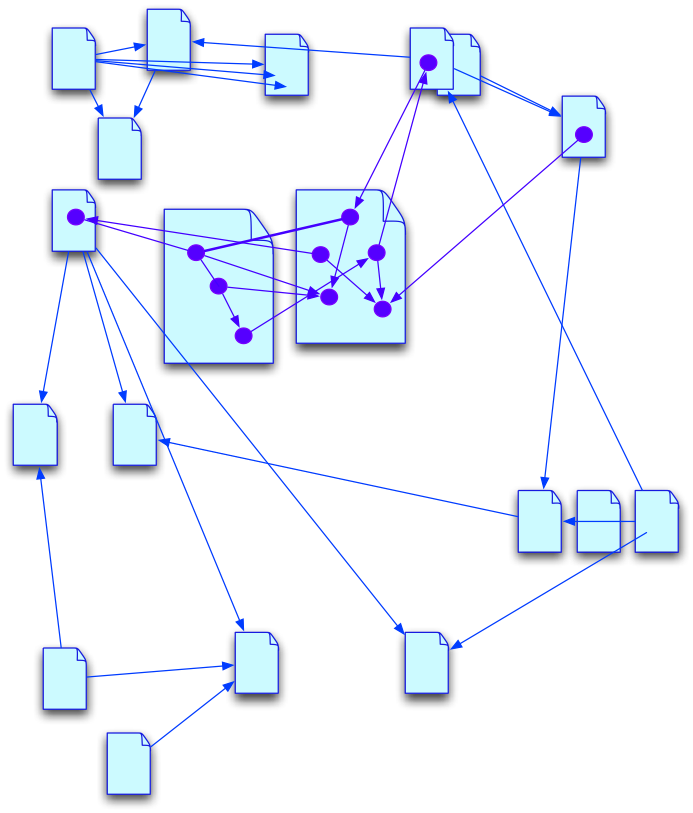
Data Web Abstraction: Data Web hides Documents
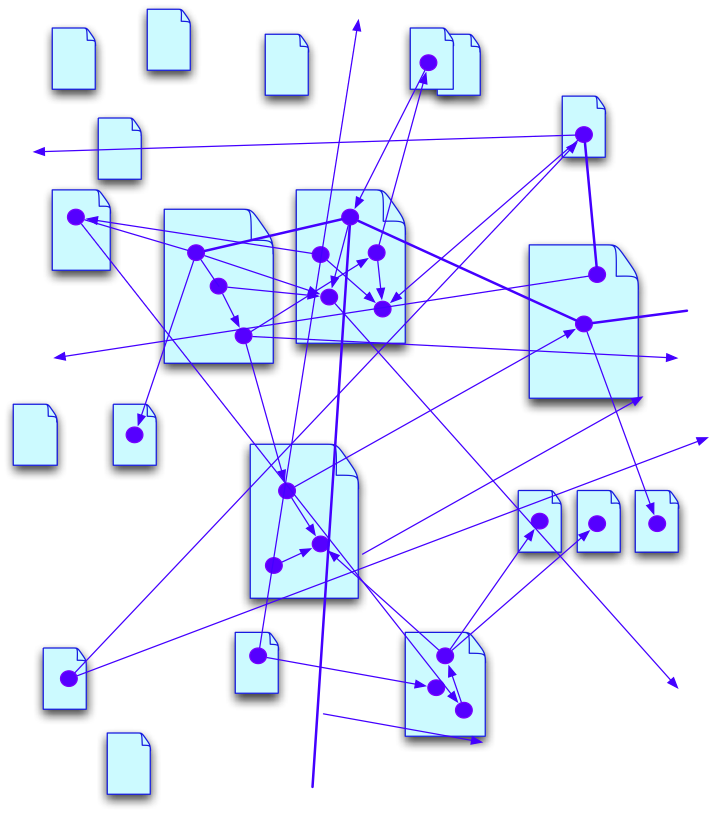
Data Web: Data links to Data

Every Network Node is an Object with an HTTP based Name (URI)

Contd: Linked Data Tenets
- Use the RDF Data Model to describe your Resources
- Use HTTP-based Resource Names
(URIs) when creating RDF Data Model records (Triples)
Linked Data & ODBC Similarities
- An ODBC Data Source Name (DSN) is equivalent to a Linked Data URI
- An ODBC Data Source is equivalent to a Linked Data Resource.
Linked Data & ODBC Similarities
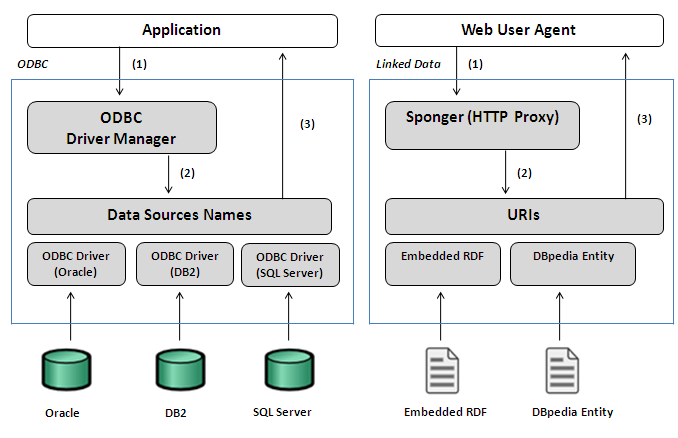
Linked Data & ODBC Differences
- Open Database Connectivity Lacks:
- Model Dexterity
(tightly bound to Relational Model)
- Reference Granularity
(stops at Table/View level)
- HTTP protocol component in Naming Scheme
(vulnerable to DBMS engine, Host OS, Network Protocol, and other infrastructural specificity)
What is the Linked Data Web?
- A World Wide Web of Named Data Sources (describing Documents or other Things)
- A Giant Global Graph of Named Data Sources where Hyperdata Links provide the Link Tapestry
- A evolution of the Web where the Description of anything is discernible via it's Data Source Name (URI).
How will Linked Data Materialize on the Web?
- Generated "on the fly" via RDF middleware from:
- Existing Web Pages
(POSH, Microformats, eRDF, RDFa, GRDDL)
- Web 2.0 Data Spaces
(Social Networks, Blogs, Wikis, Bookmarks, Online Discussions / Conversations etc)
- Web Services
(SOAP and REST)
- Enterprise Data Sources
- SOA oriented Web Services
- XML based Data Warehouses and Views
- Enterprise Databases (ODBC, JDBC, OLE-DB, ADO.NET, XMLA, Native CLIs)
- Community driven extraction efforts
Linked Data Generation from Existing Dynamic Web Content
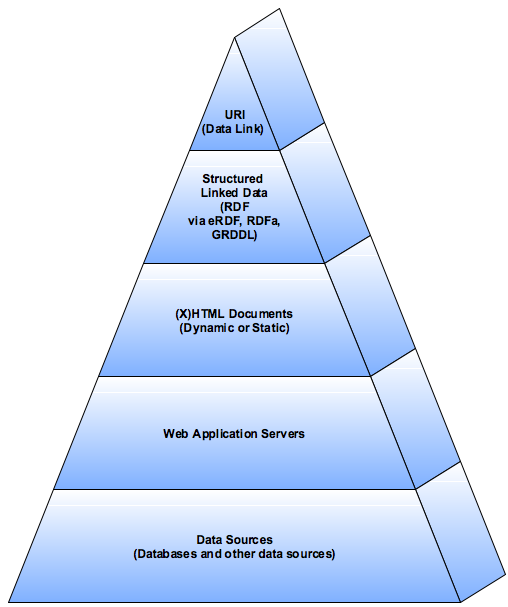
Linked Data Generation from Existing Web Services
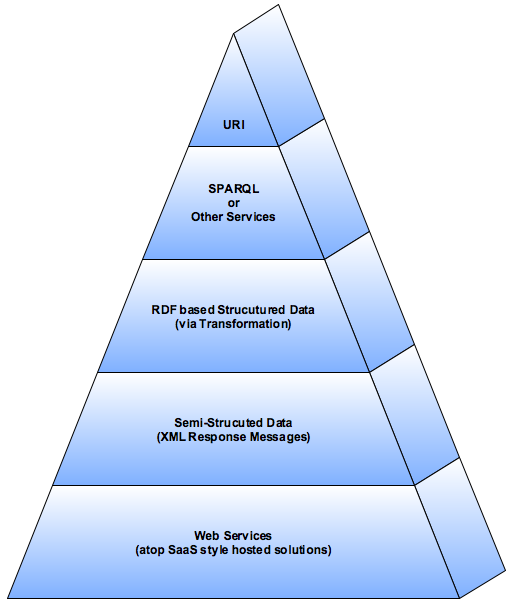
Linked Data Generation from Enterprise Data Sources
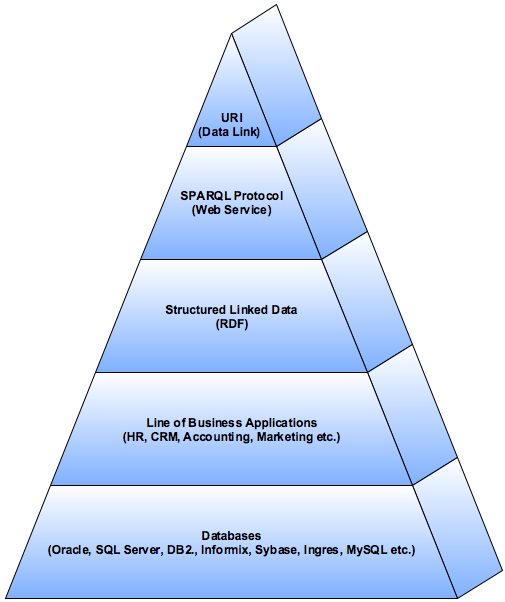
Linked Data Generation from Relational Databases
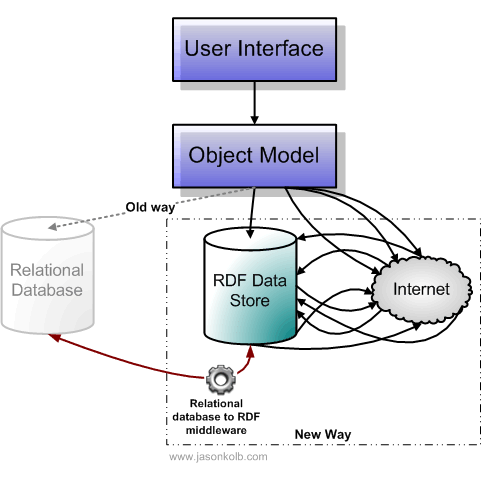
Linked Data Generation from Existing Web Content
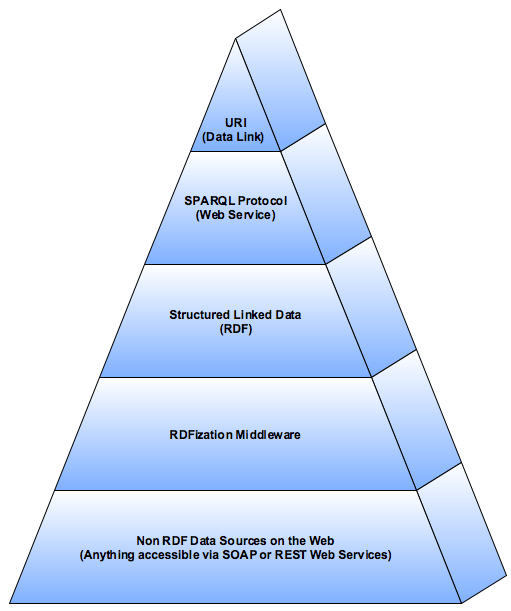
How Do I Deploy Linked Data?
- Obtain a Linked Data Server capable of:
- Creating URL rewrite-rules for handling Content Negotiation requests
- Associating URL rewrite-rules with RDF data store queries using SPARQL
- Generating Information Resources "on the fly" that provide physical provenance to Resource Descriptions
- Minting dereferenceable HTTP URIs (including wrapper/proxy URIs for non RDF Linked Data Source)
- Incorporating RDFization for transforming non-RDF Data into RDF)
Linked Data Access Mechanics
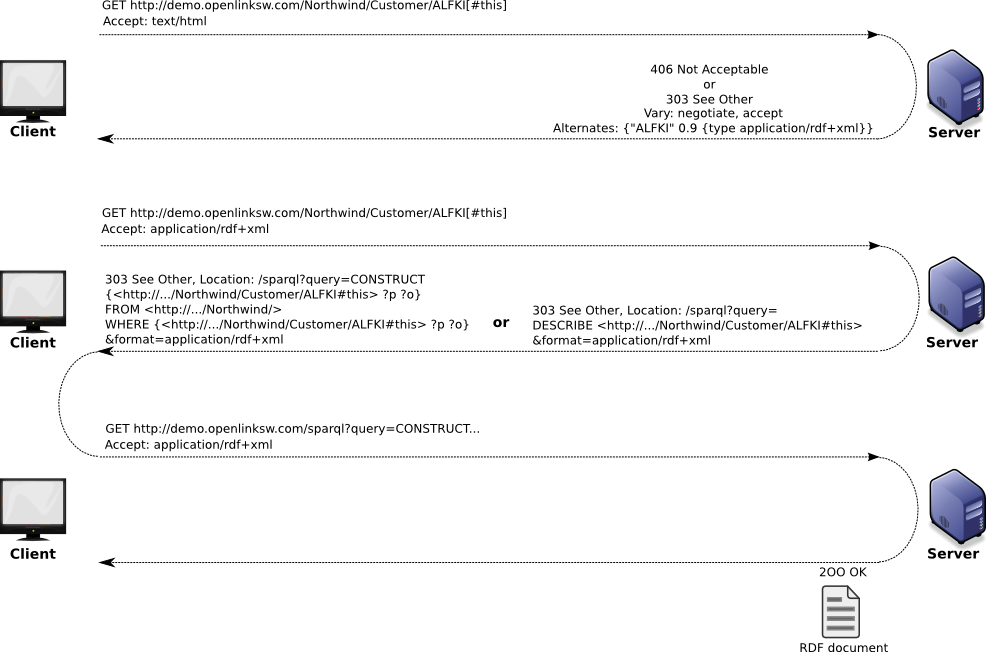
Linked Data Publishing Tenets
- When a "User Agent" requests (X)HTML, make a "best effort" to expose associated RDF data via any of the following:
- Use the <head/> section's <link/> tag to expose RDF Data Source Names
- Use simple RDFa or eRDF statements to embedded RDF Data Source Names within the (X)HTML via the <head/> section's <profile/> tag for eRDF or RDFa use declaration and <link/> tag to expose RDF Data Source Names
- If XHTML, use GRDDL to glean RDF from the source document via a combination of the GRDDL use declaration in the <head/> section's <profile/> tag and an XSLT stylesheet exposed via the <link/> tag
- When a "User Agent" requests XML
- Use GRDDL to Identity Transformation Stylesheet
Linked Data Usage Examples
Linked Data Exploitation: Web
- Data Silos will Die!
- Context [as opposed to Content] becomes King!
- Meshing (natural data linking) will replace Mashing (brute-force data linking)
- Crystallization of Information at Your Fingertips vision without platform comprises
Virtuous Cycle Example: Wikis
Virtuous Cycle Example: Blogs
Virtuous Cycle Example: Social-Networking
- Construction & Deconstruction of Social-Networks will become a loose function of data links exposed via:
- Our Tags
- Our Interests
- Our Realms of Discourse (comments associated with Blogs, Wikis, and other Data Spaces on the Web)
- It's Community, Stupid!
- Community-building prowess will express Vitality
- Vitality will be an expression of "Link Density"
- Co-petition will thrive.
A Personal Linked Data Space
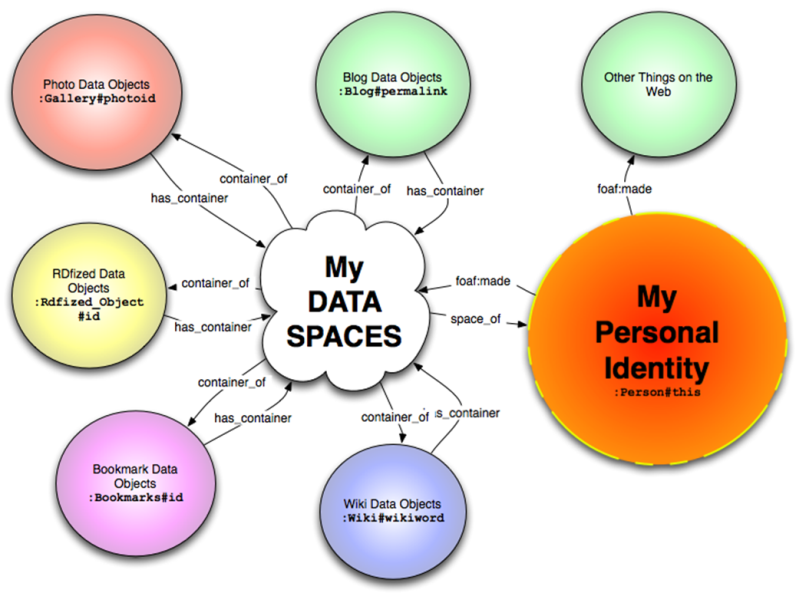
Collective Intelligence
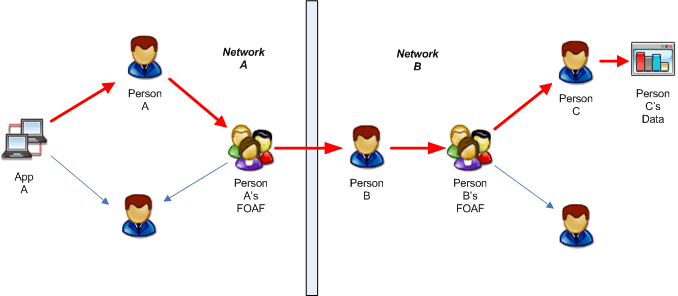
Linked Data Exploitation: Enterprise
- Conceptual interaction with Heterogeneous Data Sources that transcends
- DBMS engine models
- DBMS engine vendors APIs
- SOA Web Services
- Host Operating Systems
- Simply "Peel-Back" the containment of Applications by integrating Linked Data Source Names into
- ERP Systems
- CRM Systems
- Enterprise Collaboration Systems
- HR Systems
- Marketing Systems
- Web Content Management & Corporate Communications Systems
Linked Data -- The Web Done Right?
Yes, because it facilitates:
- Broadening our perspectives (pivoting on data behind documents)
- Serendipitous Discovery of relevant things via the Web
- Exploitation of collective intelligence via Discourse, Discovery and Participation
Additional Information
- OpenLink Software:
- Linking Open Data Community Projects
















